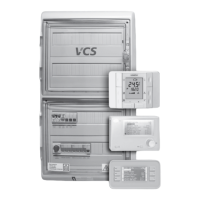20
Temperature modes
e VCS control unit system offers the possibility to maintain
the controlled room or supply air temperature using two user
adjustable temperature modes:
n Comfortable (normal mode usually used for temperature
control)
n Economy (e.g. night moderate heating)
Temperature modes are defined by the levels and staging of
the required temperature set-points, respectively the tem-
perature difference (systems with heating and cooling) – i.e.
according to the environment comfort. ey also affect the
operating energy demand. Each temperature mode is defined
by the temperature settings for heating (lower environment
temperature limit – minimum temperature) and the tempera-
ture settings for cooling (upper limit – maximum temperature).
e area of maintained controlled temperature ("dead zone")
lies between these temperature set-points. Of course, main-
taining the pre-set temperatures is dependent on the correct
dimensioning of heating or cooling systems. Temperature
modes are correlated so that the less comfortable mode has
the required temperature:
n For heating, the required temperature (lower limit) is
always lower than (or the same as) the more comfortable
mode.
n For cooling, the required temperature (upper limit) is always
greater than (or the same as) the more comfortable mode
For more comfortable modes in systems with both heating and
cooling, the environment temperature "dead zone" is always
narrower (or the same). Temperature modes are pre-set, see
Data Points, Setting – Temperature Modes.
Note: e system automatically monitors the above-men-
tioned temperature correlation and immediately adjusts the
information about the possible maximum and minimum of
each value depending on the user settings.
Warning
Settings, respectively the control process, also affect the
correction values.
Time modes
e VCS control unit system provides the possibility to control
operation depending on pre-set time schedules (modes).
n Daily schedule – allows max. 6 changes per day (mode
with the lowest priority)
n Weekly schedule – allows max. 7 changes per week
n Exception schedule – allows max. 10 changes per week
Switch-off schedule – allows max. 10 changes (mode with
the highest priority)
ese modes interact, applying the system priorities. At any
time, the air-handling operation is always controlled by the
time schedule with the highest priority provided that it has
an active time interval for that moment. e weekly and daily
schedules can be overridden by the exception schedule or
switch-off schedule at any time. e daily schedule is arranged
for each day of the week.
e weekly schedule is the same for each week of the year.
Requirements for specific days (e.g. holidays) must be sched-
uled within the exception time schedule.
Temperature modes, Time modes
e following parameters are set for the weekly and daily
schedules:
n Start time (= end of previous interval)
n Fan output (speed) stages
n Temperature mode
e exception and switch-off schedules can be set for:
n Date – day of the week
n Range of days – a period (e.g. holiday)
n Week – days of the week (Monday, Tuesday,…)
e default setting is weekly and daily time schedule.
Temperature modes in weekly and daily time schedules can
be set using the HMI-SG controller in List of Data Points in the
Settings section – Temperature modes, the chapter Control
(HMI-SG controller). e exception and switch-off schedules
can be set using HMI-DM, HMI-TM or HMI@Web controllers.
Date
Starting day: *,01.01.12
1st January 2012 is the specific day
of operation.
Starting day: Mo,*.*.**
Every Monday is the specific day of
operation.
Starting day: *,*.Even.**
Every even month (February, April,
June,…) is the specific month of
operation in each year.
Range of Days
Starting day: *,23.06.12
End: *,12.07.12
Days from 23rd June 2012 to 12th
July 2012 are the specific days of
operation in the year.
Starting day: *,23.12.**
End: *,31.12.**
Days from 23rd to 31st December
are the specific days of operation
in each year.
Starting day: *,23.12.11
End: *,01.01.12
Days from 23rd December 2011 to
1st January 2012 are the specific
days of operation.
Starting day: *,*.*.**
End: *,*.*.**
An exception time schedule or a
switching off schedule is perma-
nently active and the weekly program
will not be applied!
Week
Day of the week: *,fri,*
Every Friday is the specific day of
operation
Day of the week: *,Fri,Even
Every Friday in an even month (Febru-
ary, April, June,…) is the specific day
of operation
Day of the week: *,*,*
When the starting day is entered in
this way, an exception time schedule
or a switching off schedule is perma-
nently active and the weekly program
will not be applied!
Day of the week: 2.,*,*
e second week of every month is
the specific day of operation.
Time Schedule Operating Settings

